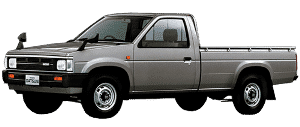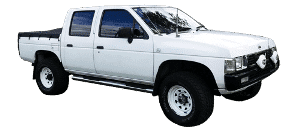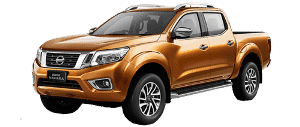The History of NAVARA
How the Navara was born
 NISSAN’S light-truck history can be traced back to 1920 and the early days of its DAT organisational predecessor. From 1947 Datsun, as DAT became from the early 1930s, recommenced pre-war pickup production, but it wasn’t until 1955 that the first modern model, the 120 Pickup, was introduced.This evolved into the 1957 220 and then the 320 in 1962. The fourth-generation 520, released in 1965, was derived from the ‘Banana-Bender’ Datsun Bluebird.
NISSAN’S light-truck history can be traced back to 1920 and the early days of its DAT organisational predecessor. From 1947 Datsun, as DAT became from the early 1930s, recommenced pre-war pickup production, but it wasn’t until 1955 that the first modern model, the 120 Pickup, was introduced.This evolved into the 1957 220 and then the 320 in 1962. The fourth-generation 520, released in 1965, was derived from the ‘Banana-Bender’ Datsun Bluebird.
It wasn’t until 1971 that Australians were included in Datsun’s light truck plans. That’s when the revamped 520 Pickup arrived with its 1000kg payload. It was sold alongside the smaller, 459kg payload 1200 Pickup based on the popular 1200 light car. The former was replaced by the 720 ute in 1980, but the latter continued virtually unabated until 1985. Powering the rear wheels via a four-speed manual gearbox, the 720’s 1.8-litre single-overhead cam four-cylinder engine produced 59kW of power and 133Nm of torque. A 47kW/140Nm 2.2-litre OHV diesel 720 was optional. Both engines powered 1000kg payload Single Cab, 750kg payload Dual Cab and 500kg payload King Cab pickup models, in 4×2 and 4×4 guises. Five-speed manual gearboxes replaced the old four-speed units from 1981, but not in all 720s. A larger 2.2 diesel, with 54kW/143Nm outputs, arrived from June ’83, along with circular instrumentation and a minor facelift. More changes followed in early ’85, along with the inclusion of a 71kW/172Nm 2.2-litre SOHC four-cylinder petrol engine. The 720 was replaced by the more-contemporary Navara from 1986.
D21 Navara (1986 - 1997)
 Nissan’s Navara replaced the capable but agricultural 720 light trucks in 1986. It featured a all-new front-cab offering more car-like comfort and features than any previous Nissan/Datsun utility. Initially the Navara came in single-cab pickup, dual-cab pickup and King Cab pickup, offering 4×2 or 4×4 drivetrains.Petrol engines were a 66kW/147Nm 2.0-litre SOHC and 74kW/177Nm 2.4-litre SOHC four-cylinder units in five-speed manual or four-speed auto option from 1988.
Nissan’s Navara replaced the capable but agricultural 720 light trucks in 1986. It featured a all-new front-cab offering more car-like comfort and features than any previous Nissan/Datsun utility. Initially the Navara came in single-cab pickup, dual-cab pickup and King Cab pickup, offering 4×2 or 4×4 drivetrains.Petrol engines were a 66kW/147Nm 2.0-litre SOHC and 74kW/177Nm 2.4-litre SOHC four-cylinder units in five-speed manual or four-speed auto option from 1988.
A 57kW/162Nm 25-litre OHV diesel four-cylinder engine was also available until early ’88, when it was enlarged slightly with outputs of 55kW and 160Nm.At the same time a new 58kW/173Nm 2.7 diesel with a four-speed automatic arrived on some models. Power steering was made standard on all 4×4 models from 1990. From mid-’92 the D21 facelift brought a small raft of changes and a more rounded bonnet. While the carburettor 74kW/177Nm version remained, the addition of fuel injection upped the upper-spec ST models’ 2.4-litre SOHC four-cylinder engine’s output to 91kW and 191Nm. But the big news was the installation of a 113kW/248Nm 3.0-litre SOHC 12V V6 engine in various Navara models, in either four-speed automatic or five-speed manual guises.
D22 Navara (1997 - 2015)
 The D22 was a significantly revamped version of the D21 released in 1986, and the 11th generation Nissan/Datsun utility. Built on the same 2950mm wheelbase as the previous model, the D22 sported a completely new nose and cabin, as well as a revised engine line-up. Changes to the 2.4-litre SOHC four-cylinder petrol engine resulted in 93kW of power and 198Nm of torque.
The D22 was a significantly revamped version of the D21 released in 1986, and the 11th generation Nissan/Datsun utility. Built on the same 2950mm wheelbase as the previous model, the D22 sported a completely new nose and cabin, as well as a revised engine line-up. Changes to the 2.4-litre SOHC four-cylinder petrol engine resulted in 93kW of power and 198Nm of torque.
A revised version of the nine-year old 2.7-litre diesel ‘four’ delivered 64kW and 180Nm, while a big QD32 76kW/220Nm 3.2-litre four-cylinder diesel engine was also added to the D22 range, while the V6 disappeared temporarily. Nissan did not have a suitable large turbo-diesel at the time, so it had to make do with this normally aspirated unit an all-new 3.0-litre TD motor was ready in 2001. A larger fuel tank was fitted when a small facelift was implemented in August ’99’s Series II update. Look for a chrome front bumper, a revised instrument panel, improved ergonomics and better refinement were also part of the tidy-up. Nissan also upgraded the base 2.4-litre engine with a twin-cam multi-valve version, which boosted power and torque to 110kW and 208Nm respectively. Other changes included a four-speed electronic automatic transmission for petrol models and a range of interior and exterior titivations. In August ’00 the D22 Series III lobbed in, with the return of V6 power in the form of a 120kW/248Nm 3.0-litre unit. Giving away the changes are a new front grille and headlights, a revised tail-light look and minor trim alterations. From December 2001 Nissan, unexpectedly, started a trend with the release of its D22 Series IV ST-R. Aimed at the private buyer, it combined a sporty appearance with a rugged light-truck presentation, and consequently far-outsold its initial expectations. Central to the Series IV’s appeal was a belated 110kW/314Nm 3.0-litre twin-cam ZD30 turbo-diesel four-cylinder engine option. Revised suspension tuning, to improve the D22’s ride qualities, better refinement properties, another interior upgrade and a significant frontal makeover also helped. A larger V6 petrol – a 125kW/360Nm 3.3-litre unit – usurped the 3.0 V6 in early ’03. In May ’04 Nissan had another go at improving the D22’s ride attributes, and added new trim and features to the very popular ST-R model, which accounted for more than half of all Navara sales. The D22 Navara ran co-currently with the next-generation D40 Navara launched in late ’05, as Nissan only brought in the top-line dual-cab 4×4 models.
D40 Navara (2005 - 2015)
 NISSAN launched a two-pronged light-truck strategy with the 12th-generation Navara. It pitched the D40 in the upper-scale ‘lifestyle’ end of the segment while the older D22 model continued to look after the more price-sensitive tradesperson-orientated end. In D40 guise, the Nissan utility is bigger, safer, stronger and more refined than any of its predecessors.Sourced from the same factory in Spain that supplies the closely related R51 Pathfinder 4WD station wagon, only a four-door dual-cab D40 body was available initially.
NISSAN launched a two-pronged light-truck strategy with the 12th-generation Navara. It pitched the D40 in the upper-scale ‘lifestyle’ end of the segment while the older D22 model continued to look after the more price-sensitive tradesperson-orientated end. In D40 guise, the Nissan utility is bigger, safer, stronger and more refined than any of its predecessors.Sourced from the same factory in Spain that supplies the closely related R51 Pathfinder 4WD station wagon, only a four-door dual-cab D40 body was available initially.
Two variants – the base RX and well-specified ST-X – offered the choice of a petrol or turbo-diesel engine and two transmissions. The headline engine is a 2.5-litre twin-cam four-cylinder direct-injection YD turbo-diesel unit offering 128kW of power at 4000rpm and 403Nm of torque at 2000rpm. Petrol fans can choose a 4.0-litre twin-cam VQ V6 that pumps out 198kW of power at 5600rpm and 385Nm of torque at 4000rpm. Both motors can be married to either a segment-first six-speed manual gearbox or five-speed automatic transmission. Nissan carried over its mechanical part-time four-wheel drive system that splits torque from driving the rear wheels (2H) to 50/50 front/rear (4H) at a twist of a dashboard knob. A low-ratio transfer box setting for serious four-wheel driving is also available (4L). A rear-drive-only D40 Navara lobbed in early 2006, but only in the higher-grade ST-X model. Underlining its light truck heritage, the D40’s ladder-frame chassis features independent front suspension with double wishbones and coil springs and a rigid live rear axle employing leaf springs. All models include a CD player, central locking, air-conditioning, three rear lap/sash seatbelts, child anchorage points and a rear seat cushion that flips up for increased cabin luggage capacity. The tray out back measures 2.36m2, offers 1130mm between the wheelarches and has a 1511mm internal bed length. NISSAN has been promising more variants of its D40 Navara ever since the Dual Cab made its appearance in 2005. The promised Single Cab and King Cab variants finally arrived in July 2008, and for the first time since 1988 Nissan has a Navara with extended cab space – this time with four doors and occasional-use rear seating for two. Nissan hopes to reach closer to Ausralia’s number-one selling ute, Toyota’s HiLux, with its fortified Navara range. Even if it fails on that front, Nissan can only get closer to being known as the Nissan Navara company, given that one in three Nissans already sold this year has a Navara badge on it.
NP300 Navara D23 (2015 - Present)
 Nissan finally updated its Navara line up in May 2015, ditching the two-model arrangement of selling the D22 and D40 models side-by-side and introducing the brand new, Thai-built NP300.Available in four variants (DX, RX, ST and ST-X), the all-new Navara saw the debut – on its dual-cab 4×4 variants, at least – of a coil-sprung, five-link rear end arrangement.
Nissan finally updated its Navara line up in May 2015, ditching the two-model arrangement of selling the D22 and D40 models side-by-side and introducing the brand new, Thai-built NP300.Available in four variants (DX, RX, ST and ST-X), the all-new Navara saw the debut – on its dual-cab 4×4 variants, at least – of a coil-sprung, five-link rear end arrangement.
A pair of new engines also made their debut; the 2.3-litre four-cylinder turbo diesel YS23 was available in either in a single turbo version that made 120kW and 403Nm, or a twin sequential turbo version that produced 140kW and 450Nm. Fuel figures varied from a low of 6.5 litres per 100 kilometres on the manual ST-X 4×4, to a high of 9.9L/100km on the single petrol version – a 4×2 DX running the 2.5-litre four-potter seen in X-Trail and other Nissans of the era. The Navara was offered with a six-speed manual gearbox as standard, or a seven-speed automatic sourced from the Y62 Patrol was available for an additional $2500. Initially available in 14 variants from launch, 27 variants – including 4×2, 4×4, dual-cab, king-cab and cab-chassis – were on offer by the end of 2015. All of the 4×2 variants retained a leaf-sprung rear end.
